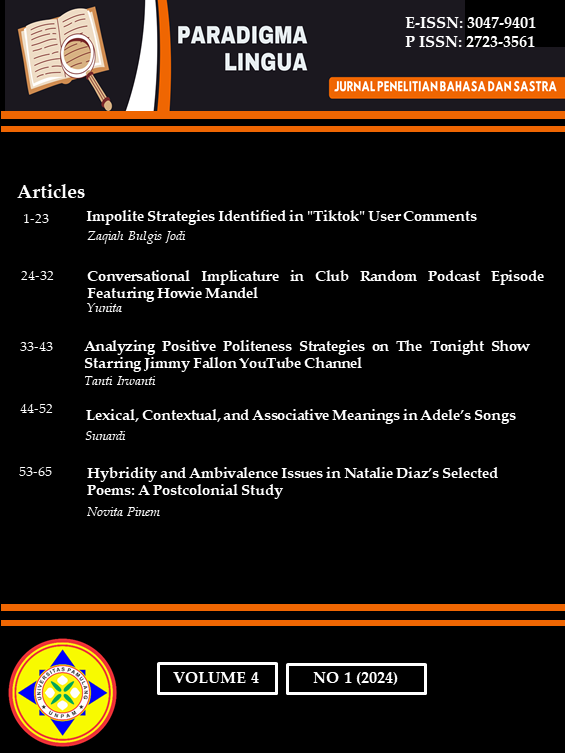Impolite Strategies Identified in "Tiktok" User Comments
Keywords:
bald on record, functions, impoliteness strategies, negative impoliteness, positive impoliteness, sarcasm.Abstract
Nowadays in modern technology, many features are provided to make people easily interact and give their opinions, e.g. column comments in social media. Unfortunately, some people use the features without filtering their language. In this case, the writer used the title “Impoliteness strategies found in Tiktok user comments”. This study then aims to analyze the type and function of impoliteness strategies used in social media, namely TikTok that had a lot of utterances that can be analyzed. The data were taken from the utterances of the TikTok user comments toward 20 videos which was posted by users who posted the video about Ariana Grande and Paige Nieman which the video consists of the differences and Paige Nieman as impersonate Ariana Grande in TikTok. The method used was descriptive qualitative. Then, to analyze the data, this study used Culpeper’s (1996) theory. The way data collected by selected the user accounts upload a video contents about Paige Nieman and Ariana Grande, then watched the video several times to identify whether the content invites negative utterances. And sorted out the comments which only contains impoliteness strategies. However, the results showed that out of 40 utterances containing impoliteness strategies, there were only four types of impoliteness strategies used in TikTok user comments, namely bald on record impoliteness, positive impoliteness, negative impoliteness, and sarcasm/mock impoliteness. The result also indicated that negative impoliteness, which consisted of 7 utterances, was the most frequently used, while sarcasm is the least frequent type of impoliteness strategy which was only 4 utterances. Moreover, this study found three functions of impoliteness strategies used in TikTok user comments. They are affective impoliteness, coercive impoliteness and entertaining impoliteness. Affective impoliteness is the most dominant function of impoliteness strategy, consisting of 28 data while entertaining is the least strategy occur in this research that is about 3 utterances.
References
Apriliyani, V., Hamzah, & Wahyuni, D. (2019). Impoliteness strategies used by male and female haters of habib rizieq and felix siauw found in instagram comments. E-Journal of English Language & Literature, 8 No.1.
Bodgan, R., & Biklen, S. K. (2007). Qualitative research for education: an introduction to theories and methods (5th ed.). Boston London: Pearson.
Brown, P., & Levinson, S. (1987). Politeness some universal in language usage. Cambrigde University Press.
Carrie, W. (2007). Research method. Journal of business & economics research (JBER).
Creswell, J. W. (2007). Research design qualitative, quantitative, and mixed methods approaches (third ed.). Losles angles.
Cruse, A. (2000). Meaning in language : an introduction to semantics and pragmatics. Oxford: Oxford University Press.
Culpeper, J. (1996). Towads an anatomy of impoliteness. Journal of pragmatics, 25, 349-367.
Culpeper, J. (2005). Impoliteness and entertaiment in the quiz show. The Weakest Link.
Culpeper, J. (2011). Impoliteness: using language to cause offence. Research gate. doi:10.1017/CBO9780511975752
Hauben, M. (1998). Netizens: On the history and impact of use net and the Internet. PEER REVIEWED JOURNAL ON THE INTERNET.
Lucky B, J. (2015). A Pragmatic analysis of impoliteness strategies in british tv-series sherlock. Yogyakarta state university.
Mey, J. L. (1993). Pragmatics : an introduction. Oxford: Blackwell.
Mills, S. (2005). Gender and impoliteness. Journal of politeness research languge brhavior culture, 263-280.
Sani, F. R. (2020). Impoliteness strategies used by the main character in the hancock movie. UIN Sunan Ampel Surabaya. Retrieved from http://digilib.uinsby.ac.id/id/eprint/43939
Yule, G. (1996). Pragmatics. Hongkong: Oxford University Press.
Published
Issue
Section
License
Authors who publish with this journal agree to the following terms:
- Authors retain copyright and grant the journal right of first publication with the work simultaneously licensed under a Creative Commons Attribution License that allows others to share the work with an acknowledgement of the work's authorship and initial publication in this journal.
- Authors are able to enter into separate, additional contractual arrangements for the non-exclusive distribution of the journal's published version of the work (e.g., post it to an institutional repository or publish it in a book), with an acknowledgement of its initial publication in this journal.
- Authors are permitted and encouraged to post their work online (e.g., in institutional repositories or on their website) prior to and during the submission process, as it can lead to productive exchanges, as well as earlier and greater citation of published work (See The Effect of Open Access).
Paradigma Lingua have CC-BY-SA or an equivalent license as the optimal license for the publication, distribution, use, and reuse of scholarly work.
In developing strategy and setting priorities, Paradigma Lingua recognize that free access is better than priced access, libre access is better than free access, and libre under CC-BY-SA or the equivalent is better than libre under more restrictive open licenses. We should achieve what we can when we can. We should not delay achieving free in order to achieve libre, and we should not stop with free when we can achieve libre.


